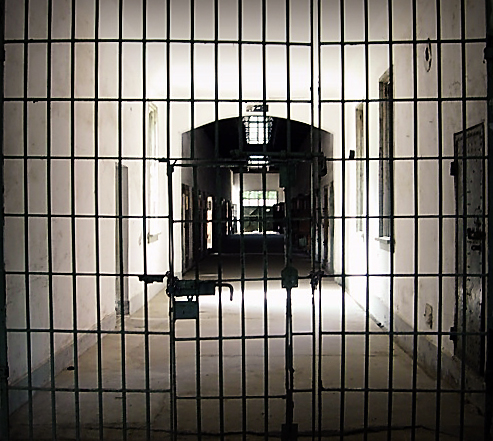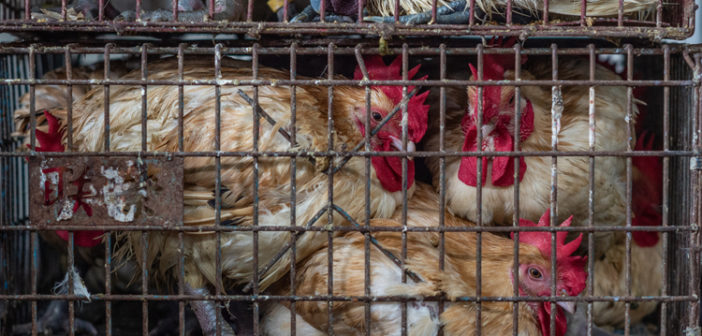This writing was originally printed in Project Intersect #1: Clarion Call”
My name is Mike, and I am a white settler residing on Attawandaron Territory, trying to connect the issue of prison abolition and animal liberation. While I have immense privileges that prevent me from fully grasping the oppression enacted by the prison industrial complex, I will approach this subject from my own experience and academic education in the subject of “criminology.”
Why do we have cages?
Because we live in a very violent and oppressive society, where governments and industries have taught us to believe imprisonment of one another are the solutions to – and not the symptoms of – complex social problems.
Need to conserve an endangered species? Put them in zoos! Need some community entertainment? Visit the aquarium tanks! Need to “advance science”? Build more cages for animal testing!
Of course, all this is just a big nasty consequence of our institutionalized speciesism. As for our human prisons, we can recognize a parallel oppressive mentality guiding our way of addressing social issues.
As Black feminist and prison abolitionist Angela Davis explained,
“Prisons do not disappear social problems, they disappear human beings… Homelessness, unemployment, drug addiction, mental illness, and illiteracy are only a few of the problems that disappear from public view when the human beings contending with them are relegated to cages.”
The system of incarceration (where jails are used to exile, punish and supposedly “rehabilitate”) exists as a limb of the criminal legal system used by settler colonial governments across Turtle Island [the name used by some indigenous people for the land mass now called the United States]. It is used in combination with law enforcement (surveillance of communities to police, intimidate and arrest) and the judiciary system (courts to judge, convict and sentence punishments).
This criminal legal system is founded on a punitive model of retribution, which assumes that punishment will bring justice and resolution to any harm caused. Consequently, prisons perpetuate systems of domination, whereby perpetrators are taken out of their communities, put into prison and then later re-integrated back into the same unequal society. The systemic relations of power and oppression are left untouched, and actually reinforced, as poverty and marginalization fuel a cycle of incarceration.
Also known as the prison industrial complex (PIC), this is a system used for capitalist gain as politicians spout “tough on crime” rhetoric to criminalize and displace our communities through prisons, jails, and juvenile and immigration detention centers.

The PIC can be better understood by simply looking at who it targets:
queer and trans* folks; communities of color; indigenous peoples; immigrants; people with disabilities and mental health issues; poor and low-income communities; drug users; and more recently, environmental and animal rights “terrorists.”
The PIC is a flourishing colonial enterprise. Despite declining crime rates, Canada’s imprisonment of people of color has increased by 75% in the past decade. Indigenous peoples continue to comprise nearly 25% of the prison population – despite only encompassing 4% of the people living within these borders – and incarceration rates of Indigenous women and girls have increased by 80% in the past decade.
In addition to this blatant racism, prisons don’t work. Prisons don’t reduce recidivism and don’t help change abusive behavior or the social conditions that contribute to each incident of violence (such as poverty). So instead of addressing social harms and the conditions that breed violence, prisons only isolate and disempower people further, worsening their behavior and situation.
Despite the role that prisons play in propping up capitalism, white supremacy, patriarchy, colonialism and other oppressive systems, this violent logic of retribution permeates campaigns for animal rights. From activist commentary to “test on criminals, not animals,” or banner slogans of “jails are for the guilty [and not marine animals],” to petitions for the greater criminalization of animal abuse, we rely on appeals to the state and social elites to discipline and punish our communities. It is made to seem as if these powers are somehow neutral within the wider scheme of speciesist violence.
Remembering that part of the logic of prisons is to expel people from society, we need to stop protest chants screaming for “animal abusers” to “leave town,” because this only encourages perpetrators to go to another community and commit harm again.
Undercover animal abuse investigations are among the most popular strategies used by mainstream animal rights activists. With many case examples of gross abuse and neglect of animals by people employed in animal industries, we are encouraged to view resulting police raids and worker arrests as an empowering resolution. With these tactics often receiving more widespread mainstream media attention, we need to consider how criminalizing low-income, racialized workers as individuals helps to stop the systemic exploitation of nonhuman animals. How does enabling the colonial and racist PIC resemble anything like liberation?
In a society that condones, normalizes and enables violence against animals, this problem cannot be solved by locking up people. More to the point, it is the corporate and government elites orchestrating and profiting from this system of speciesist exploitation that should be held accountable.

By supporting imprisonment as a solution to violence against animals, we are advocating that the oppression of being imprisoned itself is not a problem, but only who is being oppressed. This says that caging one another is not the problem, but only the worthiness of the one in the cage.
It’s not the purpose of this writing to discuss alternative models of justice (e.g., transformative justice), so for more information on the many radical communities working outside the criminal legal system with violent sexual offenders, see Philly Stands Up! and generationFIVE; for more on community accountability, see INCITE!; and for more on prison abolition, see Critical Resistance.
Essentially, relying upon prisons and the criminal legal system reinforces the systems that speciesism depends upon. We need to view speciesist violence as both a contributor to and product of patriarchal control, capitalist oppression, institutionalized racism, internalized ableism and ongoing colonialism.
If we recognize that these oppressions are interdependent, we need to also understand that our liberation is interdependent. Securing our collective liberation requires political organizing and societal transformation away from communities being governed by domination, violence and control.
Any alternative to this system should not pretend to offer a quick-fix, or a solution that works successfully all the time in every community. Relying on the criminal legal system has taken away our initiative to organize collectively, and as result, our fractured and alienated communities don’t know how to create effective community-led responses to violence against animals.
We need to be consistent when we challenge the belief that caging and dominating one another makes our society better, and commit to a solution of total transformation away from these social systems. By even beginning to recognize the interconnecting web, with varying strands of domination, control, alienation and oppression, we have begun the process of transformation.
Featured image: chickens in a cage. Image credit Jo-Anne McArthur / We Animals.





